Leading and Managing Change: IBM's Strategic Transformation Report
VerifiedAdded on 2023/01/05
|12
|3908
|1
Report
AI Summary
This report analyzes the application of change management principles, using the transformation of IBM under Lou Gerstner as a case study. It begins with an introduction highlighting the importance of effective change management in response to external environmental pressures. The report then delves into the Kaleidoscope Model, detailing its five design choices (change path, start point, style, target, and roles) and eight features (time, scope, preservation, diversity, capability, capacity, readiness, and power), illustrating how these elements were employed during IBM's restructuring. The second part of the report focuses on theories for overcoming resistance to change, specifically exploring Kurt Lewin's Change Model (unfreeze, change, refreeze) and other strategies to manage resistance. The report concludes by summarizing the key steps taken by Gestner to address IBM's challenges and discusses how these steps are implemented within the context of the models presented.
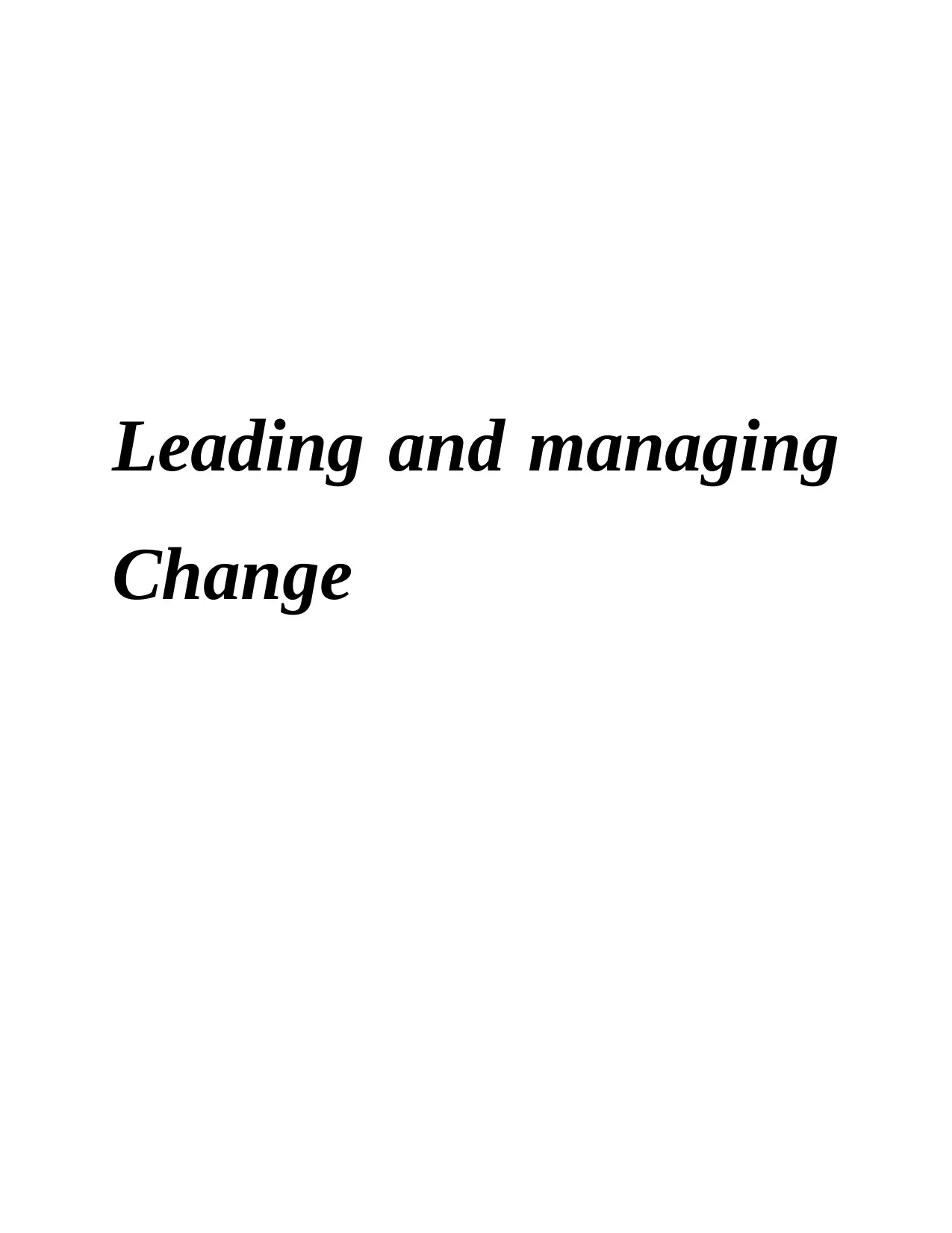
Leading and managing
Change
Change
Paraphrase This Document
Need a fresh take? Get an instant paraphrase of this document with our AI Paraphraser

Table of Contents
Introduction......................................................................................................................................3
Part 1................................................................................................................................................3
Kaleidoscope Model.....................................................................................................................3
Part 2................................................................................................................................................7
Theories to overcome the resistance to change............................................................................7
Conclusion.....................................................................................................................................11
References......................................................................................................................................12
Introduction......................................................................................................................................3
Part 1................................................................................................................................................3
Kaleidoscope Model.....................................................................................................................3
Part 2................................................................................................................................................7
Theories to overcome the resistance to change............................................................................7
Conclusion.....................................................................................................................................11
References......................................................................................................................................12

Introduction
Due to the changing external environment there are a number of changes which are brought
in organisation every day. It is necessary for managers in an organisation to make sure that they
are effectively leading through these changes in an organisation meeting all the new demands
and expectations of their customers. It is necessary for them to communicate the rationale of
changes to the employs and also inspire them throughout the process of change. The following
report consist of the change which was brought by Gestner in IBM (Ratnapalan, 2019). IBM was
first formed as computing tabulating and recording. The case study provided determines the
problems that were faced by IBM in early 1990s. Louis Vincent Gestner was appointed as
chairman in April 1993 in order to bring in the changes required to IBM. There were a number of
steps that were taken by Gestner in order to make sure that he is bringing in the organisation into
profits. The report consist of kaleidoscope model and various theories of change that explains
house different steps were taken by Gestner in order to make sure that he is overcoming the
shortfalls in organisation.
Part 1
Kaleidoscope Model
The model of change kaleidoscope was determined by Balogun and Hailey in 2004.It was
developed to help the change agent who is facing a bewildering array of different decision
implementation design of choices which are needed to make sure how the changes in an
organisation will be implemented (Baltyn, 2016). There are a number of range of decisions
choices based upon the nature of change, some of the aspect of organisational change whereas
others are the factors designs. When taking the change kaleidoscope in organisation into
consideration when Gestner took over. There are five categories of design choices as discussed
below:
Change path: there are a number of different changes which depends upon the change of path
and the incremental way of the path. It is necessary for the leader to understand different levels
of organisation and their readiness to apply the change. The change path in IBM included a
Due to the changing external environment there are a number of changes which are brought
in organisation every day. It is necessary for managers in an organisation to make sure that they
are effectively leading through these changes in an organisation meeting all the new demands
and expectations of their customers. It is necessary for them to communicate the rationale of
changes to the employs and also inspire them throughout the process of change. The following
report consist of the change which was brought by Gestner in IBM (Ratnapalan, 2019). IBM was
first formed as computing tabulating and recording. The case study provided determines the
problems that were faced by IBM in early 1990s. Louis Vincent Gestner was appointed as
chairman in April 1993 in order to bring in the changes required to IBM. There were a number of
steps that were taken by Gestner in order to make sure that he is bringing in the organisation into
profits. The report consist of kaleidoscope model and various theories of change that explains
house different steps were taken by Gestner in order to make sure that he is overcoming the
shortfalls in organisation.
Part 1
Kaleidoscope Model
The model of change kaleidoscope was determined by Balogun and Hailey in 2004.It was
developed to help the change agent who is facing a bewildering array of different decision
implementation design of choices which are needed to make sure how the changes in an
organisation will be implemented (Baltyn, 2016). There are a number of range of decisions
choices based upon the nature of change, some of the aspect of organisational change whereas
others are the factors designs. When taking the change kaleidoscope in organisation into
consideration when Gestner took over. There are five categories of design choices as discussed
below:
Change path: there are a number of different changes which depends upon the change of path
and the incremental way of the path. It is necessary for the leader to understand different levels
of organisation and their readiness to apply the change. The change path in IBM included a
⊘ This is a preview!⊘
Do you want full access?
Subscribe today to unlock all pages.

Trusted by 1+ million students worldwide
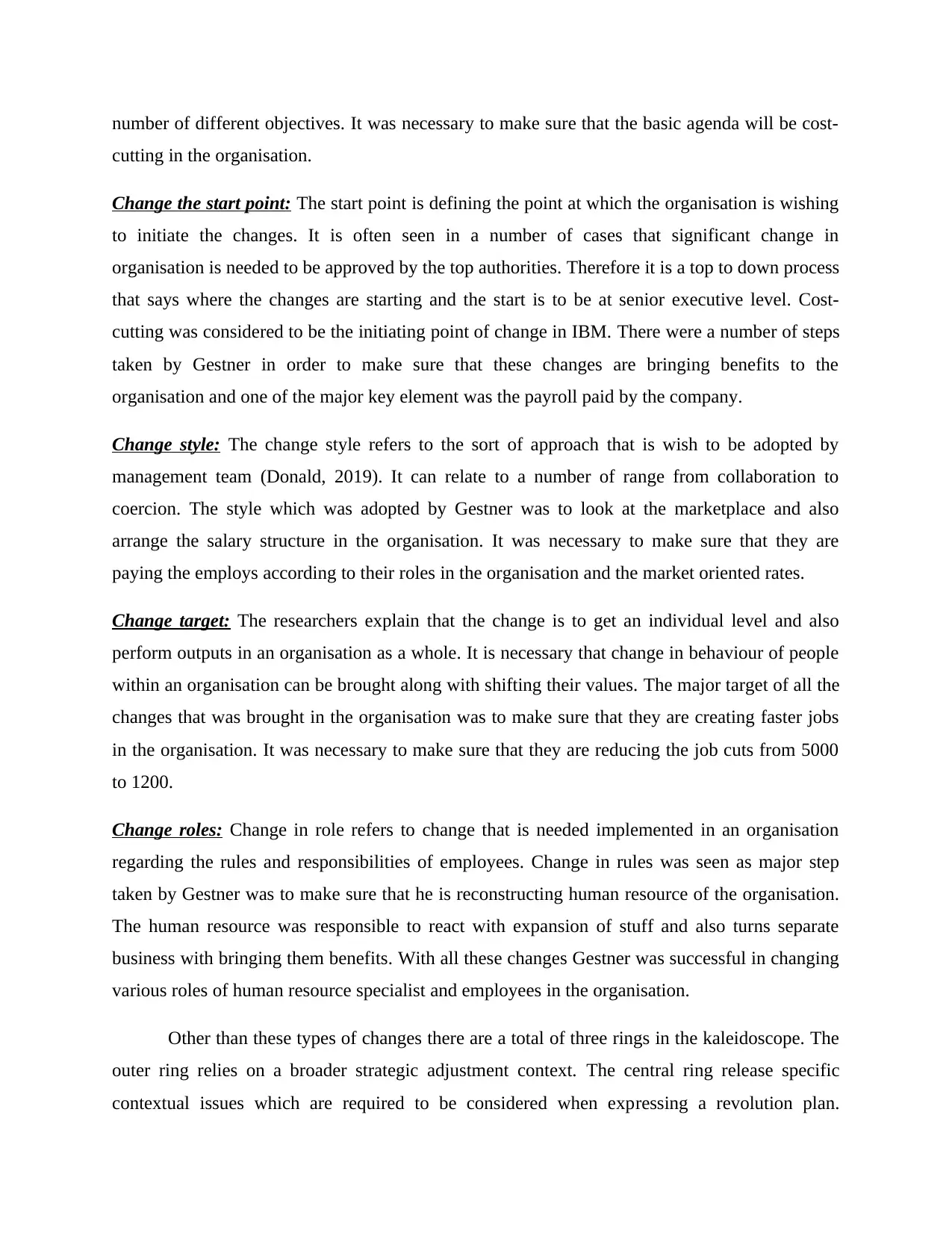
number of different objectives. It was necessary to make sure that the basic agenda will be cost-
cutting in the organisation.
Change the start point: The start point is defining the point at which the organisation is wishing
to initiate the changes. It is often seen in a number of cases that significant change in
organisation is needed to be approved by the top authorities. Therefore it is a top to down process
that says where the changes are starting and the start is to be at senior executive level. Cost-
cutting was considered to be the initiating point of change in IBM. There were a number of steps
taken by Gestner in order to make sure that these changes are bringing benefits to the
organisation and one of the major key element was the payroll paid by the company.
Change style: The change style refers to the sort of approach that is wish to be adopted by
management team (Donald, 2019). It can relate to a number of range from collaboration to
coercion. The style which was adopted by Gestner was to look at the marketplace and also
arrange the salary structure in the organisation. It was necessary to make sure that they are
paying the employs according to their roles in the organisation and the market oriented rates.
Change target: The researchers explain that the change is to get an individual level and also
perform outputs in an organisation as a whole. It is necessary that change in behaviour of people
within an organisation can be brought along with shifting their values. The major target of all the
changes that was brought in the organisation was to make sure that they are creating faster jobs
in the organisation. It was necessary to make sure that they are reducing the job cuts from 5000
to 1200.
Change roles: Change in role refers to change that is needed implemented in an organisation
regarding the rules and responsibilities of employees. Change in rules was seen as major step
taken by Gestner was to make sure that he is reconstructing human resource of the organisation.
The human resource was responsible to react with expansion of stuff and also turns separate
business with bringing them benefits. With all these changes Gestner was successful in changing
various roles of human resource specialist and employees in the organisation.
Other than these types of changes there are a total of three rings in the kaleidoscope. The
outer ring relies on a broader strategic adjustment context. The central ring release specific
contextual issues which are required to be considered when expressing a revolution plan.
cutting in the organisation.
Change the start point: The start point is defining the point at which the organisation is wishing
to initiate the changes. It is often seen in a number of cases that significant change in
organisation is needed to be approved by the top authorities. Therefore it is a top to down process
that says where the changes are starting and the start is to be at senior executive level. Cost-
cutting was considered to be the initiating point of change in IBM. There were a number of steps
taken by Gestner in order to make sure that these changes are bringing benefits to the
organisation and one of the major key element was the payroll paid by the company.
Change style: The change style refers to the sort of approach that is wish to be adopted by
management team (Donald, 2019). It can relate to a number of range from collaboration to
coercion. The style which was adopted by Gestner was to look at the marketplace and also
arrange the salary structure in the organisation. It was necessary to make sure that they are
paying the employs according to their roles in the organisation and the market oriented rates.
Change target: The researchers explain that the change is to get an individual level and also
perform outputs in an organisation as a whole. It is necessary that change in behaviour of people
within an organisation can be brought along with shifting their values. The major target of all the
changes that was brought in the organisation was to make sure that they are creating faster jobs
in the organisation. It was necessary to make sure that they are reducing the job cuts from 5000
to 1200.
Change roles: Change in role refers to change that is needed implemented in an organisation
regarding the rules and responsibilities of employees. Change in rules was seen as major step
taken by Gestner was to make sure that he is reconstructing human resource of the organisation.
The human resource was responsible to react with expansion of stuff and also turns separate
business with bringing them benefits. With all these changes Gestner was successful in changing
various roles of human resource specialist and employees in the organisation.
Other than these types of changes there are a total of three rings in the kaleidoscope. The
outer ring relies on a broader strategic adjustment context. The central ring release specific
contextual issues which are required to be considered when expressing a revolution plan.
Paraphrase This Document
Need a fresh take? Get an instant paraphrase of this document with our AI Paraphraser
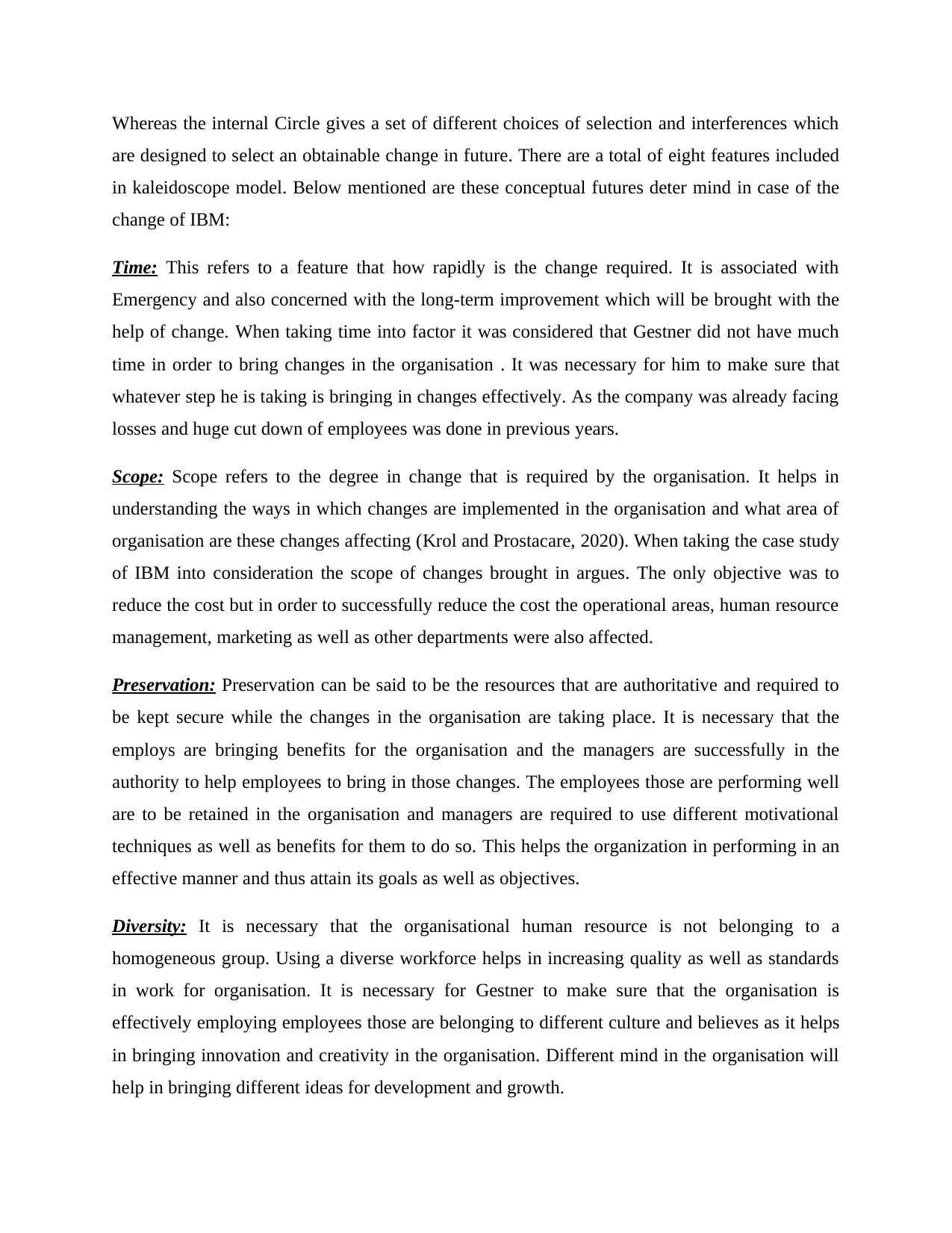
Whereas the internal Circle gives a set of different choices of selection and interferences which
are designed to select an obtainable change in future. There are a total of eight features included
in kaleidoscope model. Below mentioned are these conceptual futures deter mind in case of the
change of IBM:
Time: This refers to a feature that how rapidly is the change required. It is associated with
Emergency and also concerned with the long-term improvement which will be brought with the
help of change. When taking time into factor it was considered that Gestner did not have much
time in order to bring changes in the organisation . It was necessary for him to make sure that
whatever step he is taking is bringing in changes effectively. As the company was already facing
losses and huge cut down of employees was done in previous years.
Scope: Scope refers to the degree in change that is required by the organisation. It helps in
understanding the ways in which changes are implemented in the organisation and what area of
organisation are these changes affecting (Krol and Prostacare, 2020). When taking the case study
of IBM into consideration the scope of changes brought in argues. The only objective was to
reduce the cost but in order to successfully reduce the cost the operational areas, human resource
management, marketing as well as other departments were also affected.
Preservation: Preservation can be said to be the resources that are authoritative and required to
be kept secure while the changes in the organisation are taking place. It is necessary that the
employs are bringing benefits for the organisation and the managers are successfully in the
authority to help employees to bring in those changes. The employees those are performing well
are to be retained in the organisation and managers are required to use different motivational
techniques as well as benefits for them to do so. This helps the organization in performing in an
effective manner and thus attain its goals as well as objectives.
Diversity: It is necessary that the organisational human resource is not belonging to a
homogeneous group. Using a diverse workforce helps in increasing quality as well as standards
in work for organisation. It is necessary for Gestner to make sure that the organisation is
effectively employing employees those are belonging to different culture and believes as it helps
in bringing innovation and creativity in the organisation. Different mind in the organisation will
help in bringing different ideas for development and growth.
are designed to select an obtainable change in future. There are a total of eight features included
in kaleidoscope model. Below mentioned are these conceptual futures deter mind in case of the
change of IBM:
Time: This refers to a feature that how rapidly is the change required. It is associated with
Emergency and also concerned with the long-term improvement which will be brought with the
help of change. When taking time into factor it was considered that Gestner did not have much
time in order to bring changes in the organisation . It was necessary for him to make sure that
whatever step he is taking is bringing in changes effectively. As the company was already facing
losses and huge cut down of employees was done in previous years.
Scope: Scope refers to the degree in change that is required by the organisation. It helps in
understanding the ways in which changes are implemented in the organisation and what area of
organisation are these changes affecting (Krol and Prostacare, 2020). When taking the case study
of IBM into consideration the scope of changes brought in argues. The only objective was to
reduce the cost but in order to successfully reduce the cost the operational areas, human resource
management, marketing as well as other departments were also affected.
Preservation: Preservation can be said to be the resources that are authoritative and required to
be kept secure while the changes in the organisation are taking place. It is necessary that the
employs are bringing benefits for the organisation and the managers are successfully in the
authority to help employees to bring in those changes. The employees those are performing well
are to be retained in the organisation and managers are required to use different motivational
techniques as well as benefits for them to do so. This helps the organization in performing in an
effective manner and thus attain its goals as well as objectives.
Diversity: It is necessary that the organisational human resource is not belonging to a
homogeneous group. Using a diverse workforce helps in increasing quality as well as standards
in work for organisation. It is necessary for Gestner to make sure that the organisation is
effectively employing employees those are belonging to different culture and believes as it helps
in bringing innovation and creativity in the organisation. Different mind in the organisation will
help in bringing different ideas for development and growth.
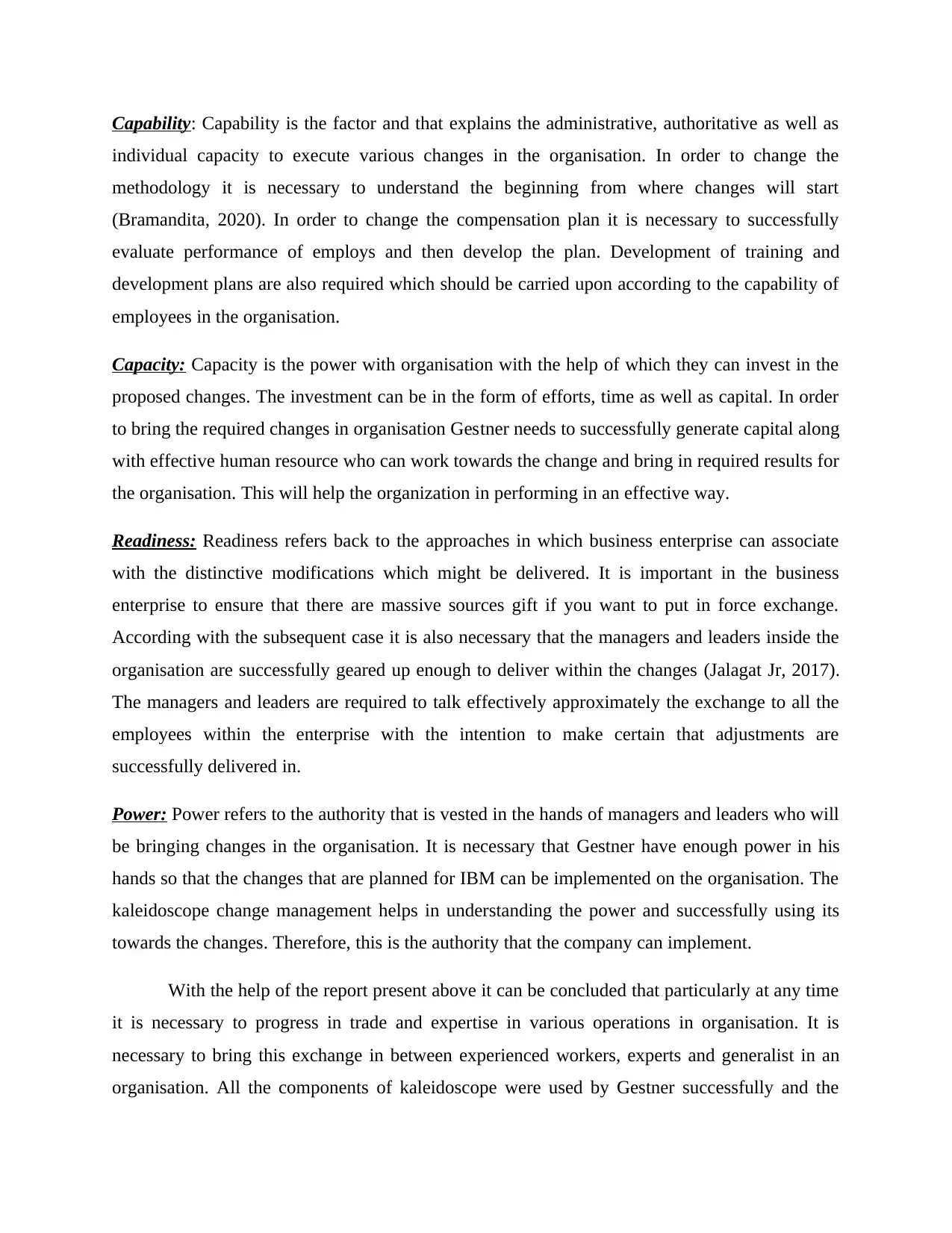
Capability: Capability is the factor and that explains the administrative, authoritative as well as
individual capacity to execute various changes in the organisation. In order to change the
methodology it is necessary to understand the beginning from where changes will start
(Bramandita, 2020). In order to change the compensation plan it is necessary to successfully
evaluate performance of employs and then develop the plan. Development of training and
development plans are also required which should be carried upon according to the capability of
employees in the organisation.
Capacity: Capacity is the power with organisation with the help of which they can invest in the
proposed changes. The investment can be in the form of efforts, time as well as capital. In order
to bring the required changes in organisation Gestner needs to successfully generate capital along
with effective human resource who can work towards the change and bring in required results for
the organisation. This will help the organization in performing in an effective way.
Readiness: Readiness refers back to the approaches in which business enterprise can associate
with the distinctive modifications which might be delivered. It is important in the business
enterprise to ensure that there are massive sources gift if you want to put in force exchange.
According with the subsequent case it is also necessary that the managers and leaders inside the
organisation are successfully geared up enough to deliver within the changes (Jalagat Jr, 2017).
The managers and leaders are required to talk effectively approximately the exchange to all the
employees within the enterprise with the intention to make certain that adjustments are
successfully delivered in.
Power: Power refers to the authority that is vested in the hands of managers and leaders who will
be bringing changes in the organisation. It is necessary that Gestner have enough power in his
hands so that the changes that are planned for IBM can be implemented on the organisation. The
kaleidoscope change management helps in understanding the power and successfully using its
towards the changes. Therefore, this is the authority that the company can implement.
With the help of the report present above it can be concluded that particularly at any time
it is necessary to progress in trade and expertise in various operations in organisation. It is
necessary to bring this exchange in between experienced workers, experts and generalist in an
organisation. All the components of kaleidoscope were used by Gestner successfully and the
individual capacity to execute various changes in the organisation. In order to change the
methodology it is necessary to understand the beginning from where changes will start
(Bramandita, 2020). In order to change the compensation plan it is necessary to successfully
evaluate performance of employs and then develop the plan. Development of training and
development plans are also required which should be carried upon according to the capability of
employees in the organisation.
Capacity: Capacity is the power with organisation with the help of which they can invest in the
proposed changes. The investment can be in the form of efforts, time as well as capital. In order
to bring the required changes in organisation Gestner needs to successfully generate capital along
with effective human resource who can work towards the change and bring in required results for
the organisation. This will help the organization in performing in an effective way.
Readiness: Readiness refers back to the approaches in which business enterprise can associate
with the distinctive modifications which might be delivered. It is important in the business
enterprise to ensure that there are massive sources gift if you want to put in force exchange.
According with the subsequent case it is also necessary that the managers and leaders inside the
organisation are successfully geared up enough to deliver within the changes (Jalagat Jr, 2017).
The managers and leaders are required to talk effectively approximately the exchange to all the
employees within the enterprise with the intention to make certain that adjustments are
successfully delivered in.
Power: Power refers to the authority that is vested in the hands of managers and leaders who will
be bringing changes in the organisation. It is necessary that Gestner have enough power in his
hands so that the changes that are planned for IBM can be implemented on the organisation. The
kaleidoscope change management helps in understanding the power and successfully using its
towards the changes. Therefore, this is the authority that the company can implement.
With the help of the report present above it can be concluded that particularly at any time
it is necessary to progress in trade and expertise in various operations in organisation. It is
necessary to bring this exchange in between experienced workers, experts and generalist in an
organisation. All the components of kaleidoscope were used by Gestner successfully and the
⊘ This is a preview!⊘
Do you want full access?
Subscribe today to unlock all pages.

Trusted by 1+ million students worldwide
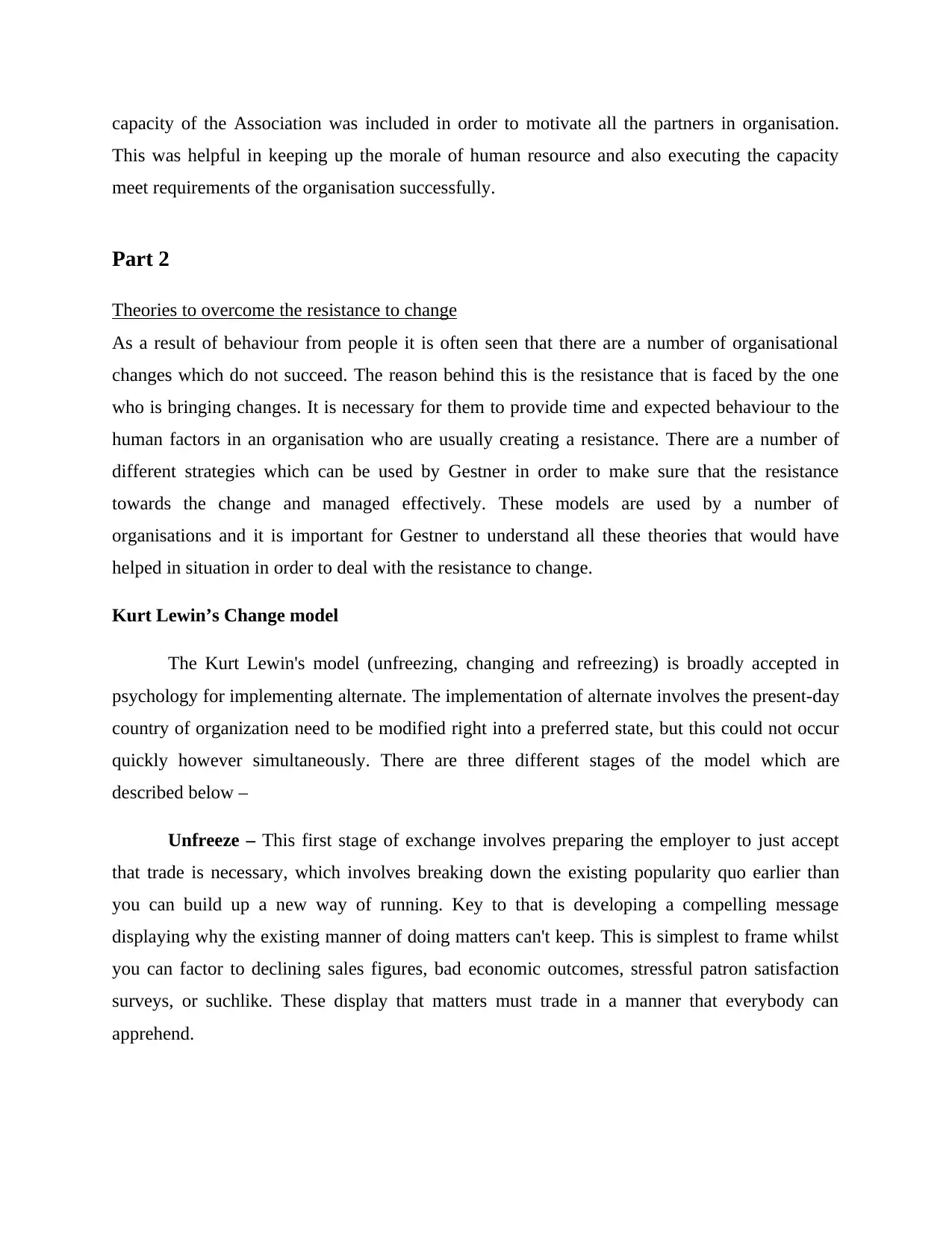
capacity of the Association was included in order to motivate all the partners in organisation.
This was helpful in keeping up the morale of human resource and also executing the capacity
meet requirements of the organisation successfully.
Part 2
Theories to overcome the resistance to change
As a result of behaviour from people it is often seen that there are a number of organisational
changes which do not succeed. The reason behind this is the resistance that is faced by the one
who is bringing changes. It is necessary for them to provide time and expected behaviour to the
human factors in an organisation who are usually creating a resistance. There are a number of
different strategies which can be used by Gestner in order to make sure that the resistance
towards the change and managed effectively. These models are used by a number of
organisations and it is important for Gestner to understand all these theories that would have
helped in situation in order to deal with the resistance to change.
Kurt Lewin’s Change model
The Kurt Lewin's model (unfreezing, changing and refreezing) is broadly accepted in
psychology for implementing alternate. The implementation of alternate involves the present-day
country of organization need to be modified right into a preferred state, but this could not occur
quickly however simultaneously. There are three different stages of the model which are
described below –
Unfreeze – This first stage of exchange involves preparing the employer to just accept
that trade is necessary, which involves breaking down the existing popularity quo earlier than
you can build up a new way of running. Key to that is developing a compelling message
displaying why the existing manner of doing matters can't keep. This is simplest to frame whilst
you can factor to declining sales figures, bad economic outcomes, stressful patron satisfaction
surveys, or suchlike. These display that matters must trade in a manner that everybody can
apprehend.
This was helpful in keeping up the morale of human resource and also executing the capacity
meet requirements of the organisation successfully.
Part 2
Theories to overcome the resistance to change
As a result of behaviour from people it is often seen that there are a number of organisational
changes which do not succeed. The reason behind this is the resistance that is faced by the one
who is bringing changes. It is necessary for them to provide time and expected behaviour to the
human factors in an organisation who are usually creating a resistance. There are a number of
different strategies which can be used by Gestner in order to make sure that the resistance
towards the change and managed effectively. These models are used by a number of
organisations and it is important for Gestner to understand all these theories that would have
helped in situation in order to deal with the resistance to change.
Kurt Lewin’s Change model
The Kurt Lewin's model (unfreezing, changing and refreezing) is broadly accepted in
psychology for implementing alternate. The implementation of alternate involves the present-day
country of organization need to be modified right into a preferred state, but this could not occur
quickly however simultaneously. There are three different stages of the model which are
described below –
Unfreeze – This first stage of exchange involves preparing the employer to just accept
that trade is necessary, which involves breaking down the existing popularity quo earlier than
you can build up a new way of running. Key to that is developing a compelling message
displaying why the existing manner of doing matters can't keep. This is simplest to frame whilst
you can factor to declining sales figures, bad economic outcomes, stressful patron satisfaction
surveys, or suchlike. These display that matters must trade in a manner that everybody can
apprehend.
Paraphrase This Document
Need a fresh take? Get an instant paraphrase of this document with our AI Paraphraser
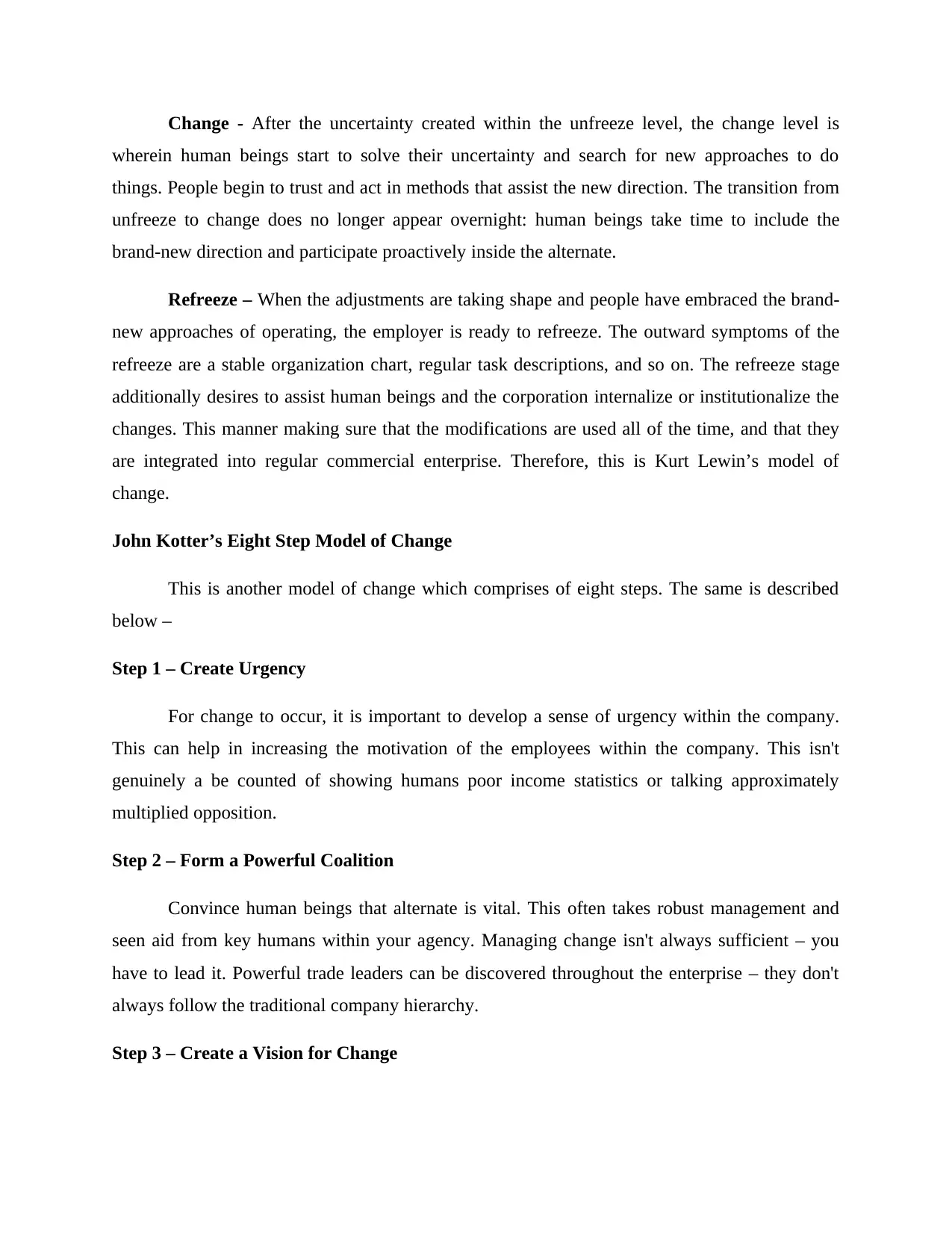
Change - After the uncertainty created within the unfreeze level, the change level is
wherein human beings start to solve their uncertainty and search for new approaches to do
things. People begin to trust and act in methods that assist the new direction. The transition from
unfreeze to change does no longer appear overnight: human beings take time to include the
brand-new direction and participate proactively inside the alternate.
Refreeze – When the adjustments are taking shape and people have embraced the brand-
new approaches of operating, the employer is ready to refreeze. The outward symptoms of the
refreeze are a stable organization chart, regular task descriptions, and so on. The refreeze stage
additionally desires to assist human beings and the corporation internalize or institutionalize the
changes. This manner making sure that the modifications are used all of the time, and that they
are integrated into regular commercial enterprise. Therefore, this is Kurt Lewin’s model of
change.
John Kotter’s Eight Step Model of Change
This is another model of change which comprises of eight steps. The same is described
below –
Step 1 – Create Urgency
For change to occur, it is important to develop a sense of urgency within the company.
This can help in increasing the motivation of the employees within the company. This isn't
genuinely a be counted of showing humans poor income statistics or talking approximately
multiplied opposition.
Step 2 – Form a Powerful Coalition
Convince human beings that alternate is vital. This often takes robust management and
seen aid from key humans within your agency. Managing change isn't always sufficient – you
have to lead it. Powerful trade leaders can be discovered throughout the enterprise – they don't
always follow the traditional company hierarchy.
Step 3 – Create a Vision for Change
wherein human beings start to solve their uncertainty and search for new approaches to do
things. People begin to trust and act in methods that assist the new direction. The transition from
unfreeze to change does no longer appear overnight: human beings take time to include the
brand-new direction and participate proactively inside the alternate.
Refreeze – When the adjustments are taking shape and people have embraced the brand-
new approaches of operating, the employer is ready to refreeze. The outward symptoms of the
refreeze are a stable organization chart, regular task descriptions, and so on. The refreeze stage
additionally desires to assist human beings and the corporation internalize or institutionalize the
changes. This manner making sure that the modifications are used all of the time, and that they
are integrated into regular commercial enterprise. Therefore, this is Kurt Lewin’s model of
change.
John Kotter’s Eight Step Model of Change
This is another model of change which comprises of eight steps. The same is described
below –
Step 1 – Create Urgency
For change to occur, it is important to develop a sense of urgency within the company.
This can help in increasing the motivation of the employees within the company. This isn't
genuinely a be counted of showing humans poor income statistics or talking approximately
multiplied opposition.
Step 2 – Form a Powerful Coalition
Convince human beings that alternate is vital. This often takes robust management and
seen aid from key humans within your agency. Managing change isn't always sufficient – you
have to lead it. Powerful trade leaders can be discovered throughout the enterprise – they don't
always follow the traditional company hierarchy.
Step 3 – Create a Vision for Change
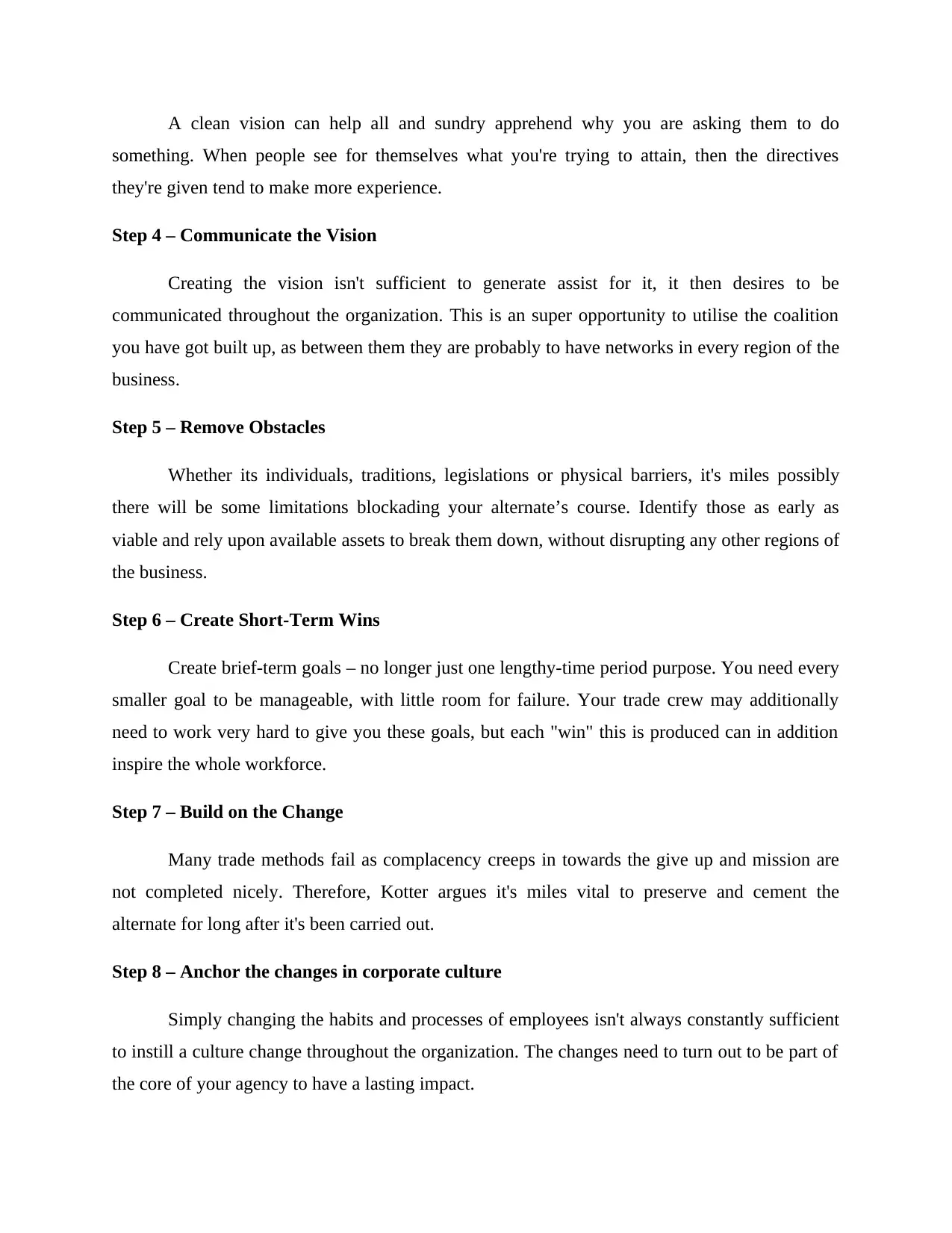
A clean vision can help all and sundry apprehend why you are asking them to do
something. When people see for themselves what you're trying to attain, then the directives
they're given tend to make more experience.
Step 4 – Communicate the Vision
Creating the vision isn't sufficient to generate assist for it, it then desires to be
communicated throughout the organization. This is an super opportunity to utilise the coalition
you have got built up, as between them they are probably to have networks in every region of the
business.
Step 5 – Remove Obstacles
Whether its individuals, traditions, legislations or physical barriers, it's miles possibly
there will be some limitations blockading your alternate’s course. Identify those as early as
viable and rely upon available assets to break them down, without disrupting any other regions of
the business.
Step 6 – Create Short-Term Wins
Create brief-term goals – no longer just one lengthy-time period purpose. You need every
smaller goal to be manageable, with little room for failure. Your trade crew may additionally
need to work very hard to give you these goals, but each "win" this is produced can in addition
inspire the whole workforce.
Step 7 – Build on the Change
Many trade methods fail as complacency creeps in towards the give up and mission are
not completed nicely. Therefore, Kotter argues it's miles vital to preserve and cement the
alternate for long after it's been carried out.
Step 8 – Anchor the changes in corporate culture
Simply changing the habits and processes of employees isn't always constantly sufficient
to instill a culture change throughout the organization. The changes need to turn out to be part of
the core of your agency to have a lasting impact.
something. When people see for themselves what you're trying to attain, then the directives
they're given tend to make more experience.
Step 4 – Communicate the Vision
Creating the vision isn't sufficient to generate assist for it, it then desires to be
communicated throughout the organization. This is an super opportunity to utilise the coalition
you have got built up, as between them they are probably to have networks in every region of the
business.
Step 5 – Remove Obstacles
Whether its individuals, traditions, legislations or physical barriers, it's miles possibly
there will be some limitations blockading your alternate’s course. Identify those as early as
viable and rely upon available assets to break them down, without disrupting any other regions of
the business.
Step 6 – Create Short-Term Wins
Create brief-term goals – no longer just one lengthy-time period purpose. You need every
smaller goal to be manageable, with little room for failure. Your trade crew may additionally
need to work very hard to give you these goals, but each "win" this is produced can in addition
inspire the whole workforce.
Step 7 – Build on the Change
Many trade methods fail as complacency creeps in towards the give up and mission are
not completed nicely. Therefore, Kotter argues it's miles vital to preserve and cement the
alternate for long after it's been carried out.
Step 8 – Anchor the changes in corporate culture
Simply changing the habits and processes of employees isn't always constantly sufficient
to instill a culture change throughout the organization. The changes need to turn out to be part of
the core of your agency to have a lasting impact.
⊘ This is a preview!⊘
Do you want full access?
Subscribe today to unlock all pages.

Trusted by 1+ million students worldwide
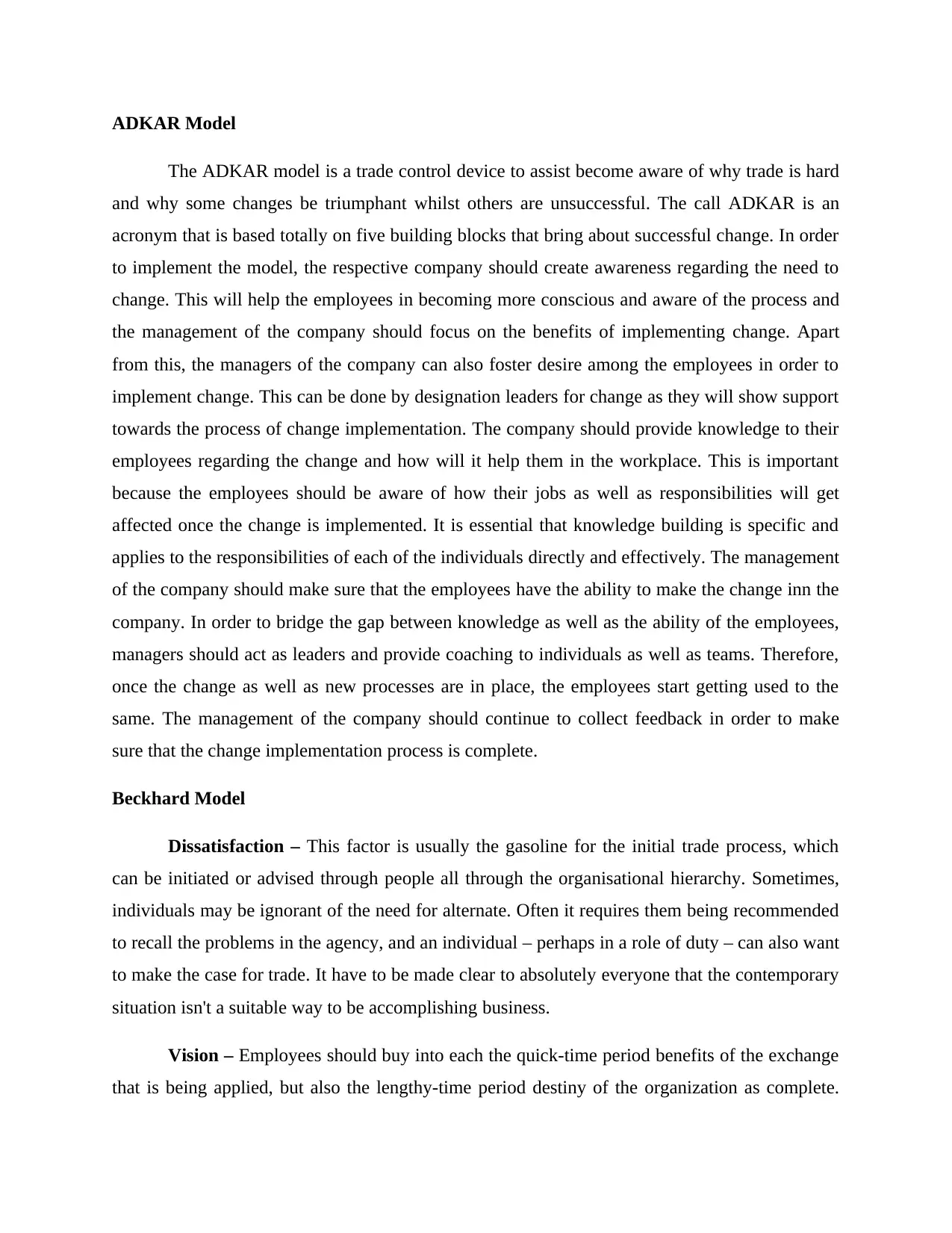
ADKAR Model
The ADKAR model is a trade control device to assist become aware of why trade is hard
and why some changes be triumphant whilst others are unsuccessful. The call ADKAR is an
acronym that is based totally on five building blocks that bring about successful change. In order
to implement the model, the respective company should create awareness regarding the need to
change. This will help the employees in becoming more conscious and aware of the process and
the management of the company should focus on the benefits of implementing change. Apart
from this, the managers of the company can also foster desire among the employees in order to
implement change. This can be done by designation leaders for change as they will show support
towards the process of change implementation. The company should provide knowledge to their
employees regarding the change and how will it help them in the workplace. This is important
because the employees should be aware of how their jobs as well as responsibilities will get
affected once the change is implemented. It is essential that knowledge building is specific and
applies to the responsibilities of each of the individuals directly and effectively. The management
of the company should make sure that the employees have the ability to make the change inn the
company. In order to bridge the gap between knowledge as well as the ability of the employees,
managers should act as leaders and provide coaching to individuals as well as teams. Therefore,
once the change as well as new processes are in place, the employees start getting used to the
same. The management of the company should continue to collect feedback in order to make
sure that the change implementation process is complete.
Beckhard Model
Dissatisfaction – This factor is usually the gasoline for the initial trade process, which
can be initiated or advised through people all through the organisational hierarchy. Sometimes,
individuals may be ignorant of the need for alternate. Often it requires them being recommended
to recall the problems in the agency, and an individual – perhaps in a role of duty – can also want
to make the case for trade. It have to be made clear to absolutely everyone that the contemporary
situation isn't a suitable way to be accomplishing business.
Vision – Employees should buy into each the quick-time period benefits of the exchange
that is being applied, but also the lengthy-time period destiny of the organization as complete.
The ADKAR model is a trade control device to assist become aware of why trade is hard
and why some changes be triumphant whilst others are unsuccessful. The call ADKAR is an
acronym that is based totally on five building blocks that bring about successful change. In order
to implement the model, the respective company should create awareness regarding the need to
change. This will help the employees in becoming more conscious and aware of the process and
the management of the company should focus on the benefits of implementing change. Apart
from this, the managers of the company can also foster desire among the employees in order to
implement change. This can be done by designation leaders for change as they will show support
towards the process of change implementation. The company should provide knowledge to their
employees regarding the change and how will it help them in the workplace. This is important
because the employees should be aware of how their jobs as well as responsibilities will get
affected once the change is implemented. It is essential that knowledge building is specific and
applies to the responsibilities of each of the individuals directly and effectively. The management
of the company should make sure that the employees have the ability to make the change inn the
company. In order to bridge the gap between knowledge as well as the ability of the employees,
managers should act as leaders and provide coaching to individuals as well as teams. Therefore,
once the change as well as new processes are in place, the employees start getting used to the
same. The management of the company should continue to collect feedback in order to make
sure that the change implementation process is complete.
Beckhard Model
Dissatisfaction – This factor is usually the gasoline for the initial trade process, which
can be initiated or advised through people all through the organisational hierarchy. Sometimes,
individuals may be ignorant of the need for alternate. Often it requires them being recommended
to recall the problems in the agency, and an individual – perhaps in a role of duty – can also want
to make the case for trade. It have to be made clear to absolutely everyone that the contemporary
situation isn't a suitable way to be accomplishing business.
Vision – Employees should buy into each the quick-time period benefits of the exchange
that is being applied, but also the lengthy-time period destiny of the organization as complete.
Paraphrase This Document
Need a fresh take? Get an instant paraphrase of this document with our AI Paraphraser

This have to all be concentrated around the beliefs and values of the enterprise, which must
additionally be bolstered at some stage in the alternate procedure.
First Steps – It is essential that alternate is sensible. First Steps (F) refers back to the
practicality of the initial tasks required to work closer to the intention. Individually, employees
want to understand what their function could be in imposing the exchange initiative.
Resistance to Change - Even after all the vital arguments had been recommend, there is
typically at least a few herbal oppositions which remains. Humans are commonly extra
encouraged via avoiding losses than they may be of making profits and enhancements. It is
plenty easier to take no risks, hold the fame quo as it is, than to modify it entirely.
Conclusion
With the help of the above report it can be concluded that there are a number of changes that
were brought by Gestner in the organisation. All these changes were necessary to enough in
order to make sure that the organisation is earning profits and all the losses of the organisation or
set off. There are a number of frameworks described which were used by Gestner so that the
changes can be implemented successfully in the organisation. It is difficult for a leader to bring a
change in organisation. There are a number of requirements to be understood such as the change
of path, starting point, style, target, rules which will be brought in the organisation due to a
single change. The report also concludes that there are a number of resistances which will be
faced by a leader when they are bringing in change in an organisation. There are different
theories explain which can be used by leaders in order to make sure that the resistance in the
organisation towards change is minimized and all the objectives are achieved in stipulated time
period.
additionally be bolstered at some stage in the alternate procedure.
First Steps – It is essential that alternate is sensible. First Steps (F) refers back to the
practicality of the initial tasks required to work closer to the intention. Individually, employees
want to understand what their function could be in imposing the exchange initiative.
Resistance to Change - Even after all the vital arguments had been recommend, there is
typically at least a few herbal oppositions which remains. Humans are commonly extra
encouraged via avoiding losses than they may be of making profits and enhancements. It is
plenty easier to take no risks, hold the fame quo as it is, than to modify it entirely.
Conclusion
With the help of the above report it can be concluded that there are a number of changes that
were brought by Gestner in the organisation. All these changes were necessary to enough in
order to make sure that the organisation is earning profits and all the losses of the organisation or
set off. There are a number of frameworks described which were used by Gestner so that the
changes can be implemented successfully in the organisation. It is difficult for a leader to bring a
change in organisation. There are a number of requirements to be understood such as the change
of path, starting point, style, target, rules which will be brought in the organisation due to a
single change. The report also concludes that there are a number of resistances which will be
faced by a leader when they are bringing in change in an organisation. There are different
theories explain which can be used by leaders in order to make sure that the resistance in the
organisation towards change is minimized and all the objectives are achieved in stipulated time
period.
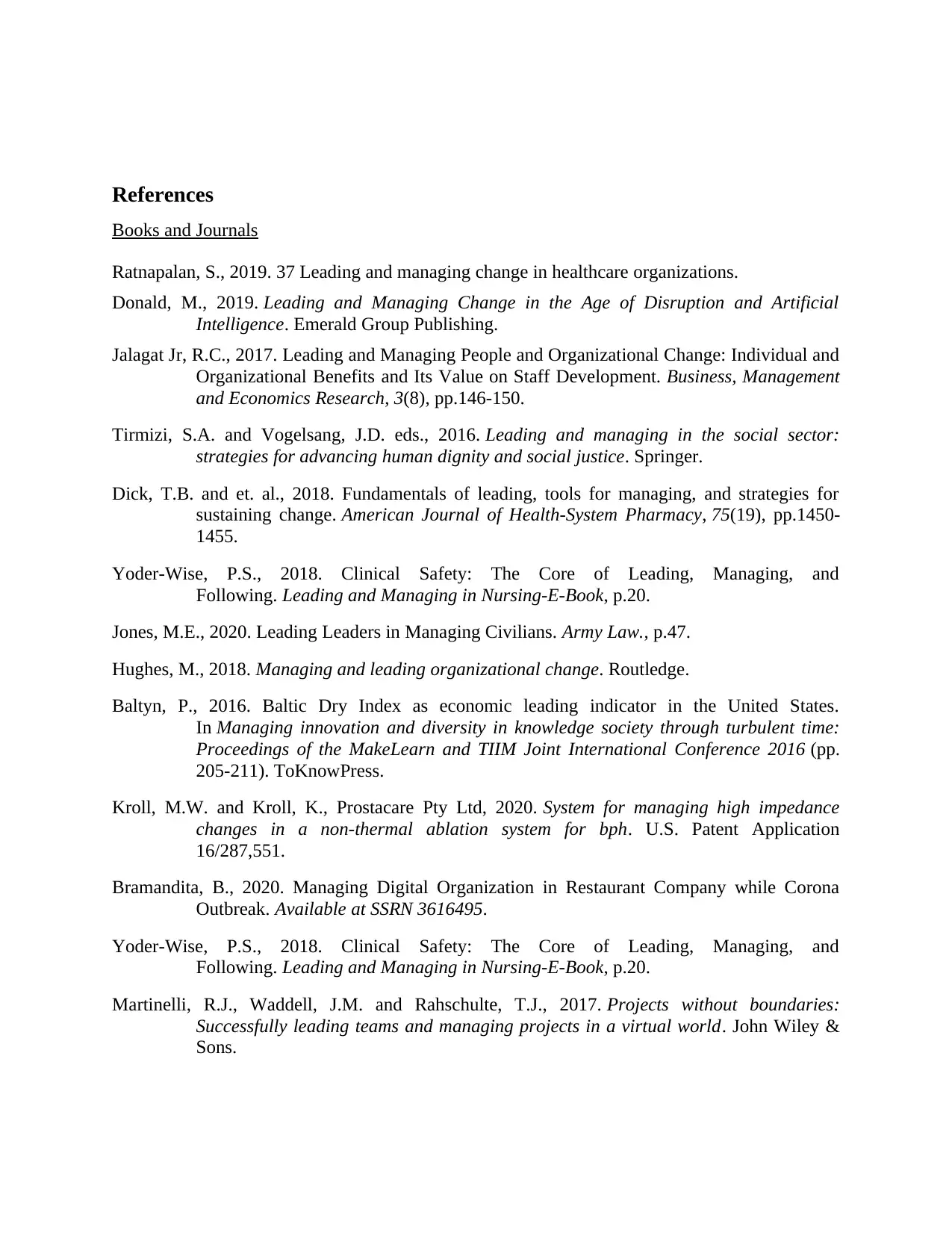
References
Books and Journals
Ratnapalan, S., 2019. 37 Leading and managing change in healthcare organizations.
Donald, M., 2019. Leading and Managing Change in the Age of Disruption and Artificial
Intelligence. Emerald Group Publishing.
Jalagat Jr, R.C., 2017. Leading and Managing People and Organizational Change: Individual and
Organizational Benefits and Its Value on Staff Development. Business, Management
and Economics Research, 3(8), pp.146-150.
Tirmizi, S.A. and Vogelsang, J.D. eds., 2016. Leading and managing in the social sector:
strategies for advancing human dignity and social justice. Springer.
Dick, T.B. and et. al., 2018. Fundamentals of leading, tools for managing, and strategies for
sustaining change. American Journal of Health-System Pharmacy, 75(19), pp.1450-
1455.
Yoder-Wise, P.S., 2018. Clinical Safety: The Core of Leading, Managing, and
Following. Leading and Managing in Nursing-E-Book, p.20.
Jones, M.E., 2020. Leading Leaders in Managing Civilians. Army Law., p.47.
Hughes, M., 2018. Managing and leading organizational change. Routledge.
Baltyn, P., 2016. Baltic Dry Index as economic leading indicator in the United States.
In Managing innovation and diversity in knowledge society through turbulent time:
Proceedings of the MakeLearn and TIIM Joint International Conference 2016 (pp.
205-211). ToKnowPress.
Kroll, M.W. and Kroll, K., Prostacare Pty Ltd, 2020. System for managing high impedance
changes in a non-thermal ablation system for bph. U.S. Patent Application
16/287,551.
Bramandita, B., 2020. Managing Digital Organization in Restaurant Company while Corona
Outbreak. Available at SSRN 3616495.
Yoder-Wise, P.S., 2018. Clinical Safety: The Core of Leading, Managing, and
Following. Leading and Managing in Nursing-E-Book, p.20.
Martinelli, R.J., Waddell, J.M. and Rahschulte, T.J., 2017. Projects without boundaries:
Successfully leading teams and managing projects in a virtual world. John Wiley &
Sons.
Books and Journals
Ratnapalan, S., 2019. 37 Leading and managing change in healthcare organizations.
Donald, M., 2019. Leading and Managing Change in the Age of Disruption and Artificial
Intelligence. Emerald Group Publishing.
Jalagat Jr, R.C., 2017. Leading and Managing People and Organizational Change: Individual and
Organizational Benefits and Its Value on Staff Development. Business, Management
and Economics Research, 3(8), pp.146-150.
Tirmizi, S.A. and Vogelsang, J.D. eds., 2016. Leading and managing in the social sector:
strategies for advancing human dignity and social justice. Springer.
Dick, T.B. and et. al., 2018. Fundamentals of leading, tools for managing, and strategies for
sustaining change. American Journal of Health-System Pharmacy, 75(19), pp.1450-
1455.
Yoder-Wise, P.S., 2018. Clinical Safety: The Core of Leading, Managing, and
Following. Leading and Managing in Nursing-E-Book, p.20.
Jones, M.E., 2020. Leading Leaders in Managing Civilians. Army Law., p.47.
Hughes, M., 2018. Managing and leading organizational change. Routledge.
Baltyn, P., 2016. Baltic Dry Index as economic leading indicator in the United States.
In Managing innovation and diversity in knowledge society through turbulent time:
Proceedings of the MakeLearn and TIIM Joint International Conference 2016 (pp.
205-211). ToKnowPress.
Kroll, M.W. and Kroll, K., Prostacare Pty Ltd, 2020. System for managing high impedance
changes in a non-thermal ablation system for bph. U.S. Patent Application
16/287,551.
Bramandita, B., 2020. Managing Digital Organization in Restaurant Company while Corona
Outbreak. Available at SSRN 3616495.
Yoder-Wise, P.S., 2018. Clinical Safety: The Core of Leading, Managing, and
Following. Leading and Managing in Nursing-E-Book, p.20.
Martinelli, R.J., Waddell, J.M. and Rahschulte, T.J., 2017. Projects without boundaries:
Successfully leading teams and managing projects in a virtual world. John Wiley &
Sons.
⊘ This is a preview!⊘
Do you want full access?
Subscribe today to unlock all pages.

Trusted by 1+ million students worldwide
1 out of 12
Related Documents
Your All-in-One AI-Powered Toolkit for Academic Success.
+13062052269
info@desklib.com
Available 24*7 on WhatsApp / Email
![[object Object]](/_next/static/media/star-bottom.7253800d.svg)
Unlock your academic potential
Copyright © 2020–2025 A2Z Services. All Rights Reserved. Developed and managed by ZUCOL.





